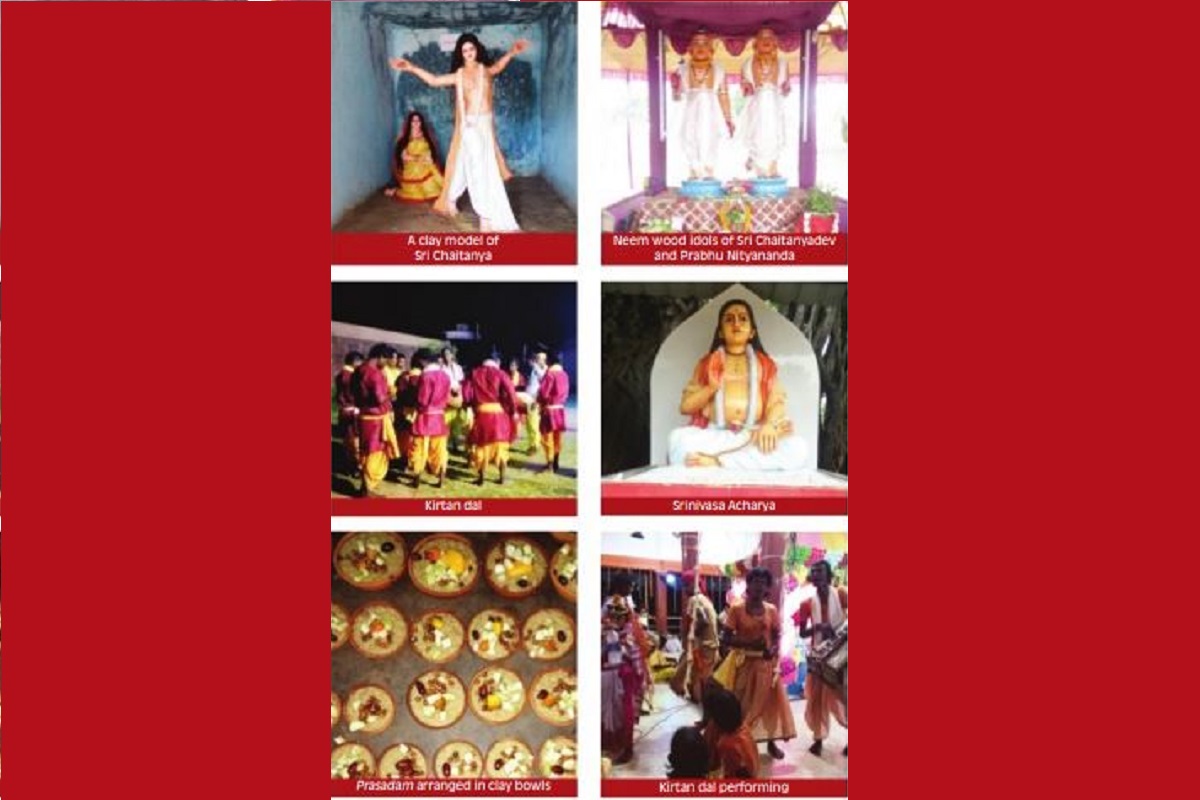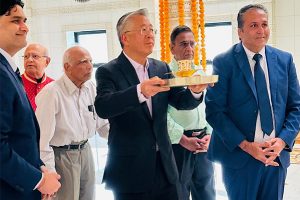In Brihannaradiya Purana, about human redemption in Kaliyug, it is said: ‘Harernama Harernama Harernamaiva Kevalam I/ Kalounashtyeva Nashtyeva Nashtyeva Gatiranyatha II’ (There is no other way, no other way, no other way of attaining redemption/Without chanting the holy names of the Lord with devotion).
Kaliyuga is fraught with sin, vice, malice and plethora of defects and drawbacks that make people antipathetic to pursue spiritual and devotional avenues for the redemption of the soul. According to various scriptures including Vishnu Purana, Brihan-Naradiya Purana, etc the sole path to elevate a common man to the sublimation of spiritual realisation is to chant and glorify the nectarine names of Lord Krishna. Vedic literature also propounds the same theory. Therefore, just only by chanting the Hare Krishna ‘maha mantra’ one can attain permanent emancipation from the cycle of birth and death and also be graced with the perennial bliss of the Lord.
The sole purpose of Harinaam SankirtanaYajna (congregational chanting to glorify the name of the Supreme Lord Hari) is to engage as many people as possible in the congregational chanting primarily and absolutely for the satisfaction of Lord Krishna. “Tashmin tushte Jagat Tushta” (Satisfaction of Lord Krishna is the satisfaction of the world) is the spirit of Sankirtana Yajna. As Lord Krishna cannot be perceived by sense organs that are meant only to relish a mundane world, Naamsankirtana is the sole vehicle that can transport one in the world of transcendence and eternal pleasure. Thus the perennial flow of Harinaam will automatically drive and elevate the plebeians in the sublimation of devotion.
Even the holy name itself is considered one of the incarnations of the Supreme Lord. Madhu Pandit Dasa, the president of Iskcon, Bangalore, in his inaugural speech in a Harinaam festival, said, “Harinaam festival is a great opportunity for all of us to absorb ourselves in chanting and hearing the holy names of the Lord. The Lord is omnipotent. He has multifarious ways to manifest Himself into material energy. The holy name is the incarnation of the Lord in the form of vibration.” The greatness of Harinaam is so high that one deserves ‘Ahaituki Kripa’ (spontaneous grace of the Lord) if one listens to or chants the nectarine Harinaam.
In the Brihannaridiya Purana Lord Narayana relates to Maharshi Narada: Naham Vasami Baikunthe Yoginaam Hridayee Na Cha: I/ Mad Bhakta Yatra Gayanti Tatra Tishthami Narada: II (Neither do I dwell in Baikuntha (the abode of Lord Vishnu) nor do I rest in the hearts of the saints. I reside only in the places where my devotees chant my names).
Naamsankirtana, or Naamgan, was first introduced in Srivasa Padit’s courtyard in Nabadwip. Srivasa Thakur symbolising devotion is one of the ‘pancatattva’ (Five Aspects of God or Absolute Truth) in Gaudiya Vaishnava. Under the aegis of Nittyananda Mahaprabhu incarnating Lord Krishna’s first personal expansion with a combined power of Balarama and another one of ‘panca tattava’, the tradition of arranging the congregational assemblage of Naamsankirtana was given the shape of a festival.
The congregations of the familial devotees were not imbued with communal and caste differences. They were run by voluntary contributions on the part of the devotees. Sri Chaitanya Mahaprabu while residing in Puri had reportedly got wind of the news of Naamsankirtana and preaching in Bengal. Besides, Sri Chaitanya Dev’s six disciples called “Sharda Vaishnavs” and their disciples were entrusted with the onus of preaching and spreading the message of the cult of devotion through Naamsankirtana far and wide.
Mallabhum is the epicentre of Sankirtan Yajna in Raardh Bhum. According to Bengali almanac, Baisakh and Jaishtha are the months of Harinaam Sankirtana, particularly in the regions which were once under the rules of or influenced by Malla Dynasty. The people of Bankura, a draught prone district in South Bengal, generally suffer from acute scarcity of water. Ordinary people here are obsessed in Naamsankirtana craving for Harinaam to be poured down in the form of a cool shower. Hardly can there be found a town or even a remote village in Bankura district and its adjoining areas where Naamsankirtana Utsav (Festival to glorify the names of Lord Krishna) is not held. The history behind the introduction of Naamsankirtana Utsav in Mallabhum is very exciting and interesting.
Debnath Bachaspati, the royal astrologer in the court of the 49th Malla King Veer Hambir, foretold that a few bullock carts fraught with priceless treasures would cross Bishnupur, the capital town of Mallabhum. The king engaged his ambushers to plunder the treasure. To the utter disappointment of the king, it was noticed that there were nothing but Vaishnava scriptures and literatures in the booties. The scriptures comprised one hundred and twenty-one books including ‘Haribhakti Vilas’, ‘Haribhakti Rashamritasindhu’, ‘Chaitanya Charitamrita’, ‘Lalit Madhav’ and other.
Srinivasa Acharya along with Narottamdas Thakur and Shyamananda were in charge of carrying the holy Vaishnava scriptures from Vrindavana to Gouriya Math in Bengal. Srinivasa Acharya for his effulgent beauty and unwavering devotion is still considered the ‘abhinna kolebor’ (identical body) of Sri Chaitanyadev in Goudya Vaishnava community. Later he came to know that the scriptures were in the king’s custody.
Later enthralled by the recitation and interpretation of the Srimad Bhagavatam by Srinivasa Acharya, the king confessed his guilt of pillage and returned all the precious scriptures to him. The king entreated Acharya to reside at Mallabhum permanently. The message of the recovery of the plundered scriptures elated the Goudya Vaishnava community so much that they celebrated the event with renewed strength and enthusiasm. Even in Kheturi, the holy birth place of Narottam Das Thakur in Rajshahi, Bangladesh, the message was welcomed in a festive mood.
From then on Srinivasa Acharya and his descendants continued to live at Bishnupur, the capital of then Mallabhum. Renowned singers like Sri Radhika Prasad Goswami and Gyanendra Prasada Goswami of Bishnupur Sangit Gharana, the only authentic musical gharana (school of music) of Bengal, belonged to this family lineage. They enriched Bishnupur Gharana. Besides, it had its early roots in the Manohar Sahi Style of kirtana propagated by Srinivasa Acharya. Hambir converted from Saktaism to Vaishnavism. Mallabhum became a sacred place of Vaishnavism. With Vaishnavism gaining popularity among plebeians, untouchability and casteism in Mallabhum were on the wane.
Then Veer Hambir became so engrossed with the passion of Vaishnavism that neglecting his royal duties, he went on a pilgrimage to Vrindavan with his adored Gurudev Srinivasa Acharya. Even the king accompanied him in the inauguration festival of Kheturi, the birthplace of great Vaishnava Narottam Das, in Rajshahi in Bangladesh. Enchanted after witnessing the “Mahoutshava”, popularly known as ‘mochchav’, in Kheturi the king also decided to arrange a festival of the same status.
Two huge joint-less (monolithic) idols of Sri Chaitanya Mahaprabhu and Nityananda Mahaprabhu were carved out of ‘neem’ wood with ‘salagram shilas’ (sacred stones) embedded inside. They were inaugurated with pomp and grandeur keeping pace with the status of Kheturi “Mahoutshava”. Thus Veer Hambir ushered Sankirtana Yajna in Mallabhum. From then on it became a vogue and spread far and wide. That tradition still continues in districts like Bankura, Purulia, Birbhum, West Midnapore and other places with much popularity.
Celebration of Sankirtana Yajna: There are a variety of nomenclatures of the Naamsankirtana festival attributed as per the number of ‘prahar’ (equal to three hours) and days the festival lasts. As a day is equal to eight ‘prahars’, the oneday festival is called ‘Ashtam Prahar’ and three-day festival ‘Chabbish Prahar’. Naamsankirtan Utsav is arranged in an odd number of days. Therefore, a five-day festival is popularly coined as ‘Pancha Ratri’ and nine-day as ‘Nava Ratri’.
Two wooden, or clay or stone idols of the figures of Goudya Vaishnavism Sri Chaitannysdev and His inseparable confrere Prabhu Nityananda are generally installed at the holy altar during Naamsankirtana festival. The message of Sankirtan Yajna is disseminated and delivered hanging chains of mango twigs. Clay models and human statues on the life story of Sri Chaitanyadev are installed to give a new lease of life to the festival. The worshippers generally become the descendants of some great Vashnavite family.
The eve of the Naamsankirtana festival is called ‘Adhiwas’. It is followed by the auspicious day of the inauguration of the holy candle popularly known as ‘Gandha Diwas’ or ‘Jagar’. The holy candle once lit must not be extinguished till the last day of the Naamsankirtana festival called ‘Dhulatu’ (celebration with dust and ‘abir’). The last night of Naamsankirtana Utsav called ‘Jagran’ is specially celebrated with more enthusiasm than other usual days.
The fair ground is crowded with devotees chanting Naamgan (song hailing the Lord) whole of the night. The celebration of ‘Dhulatu’ is observed with dust and ‘abir’ (coloured powder) eradicating all forms of schism among humanity irrespective of cast, creed, colour, gender and, above all, social and economic status. A craze for rolling on the dusty ground is observed among the devotees to celebrate the valedictory ceremony of the days-long congregational chanting of the holy name of Krishna, the Supreme Lord.
The main musical instruments used during Naamsankirtana are ‘mridanga’ and ‘srikhol’ (two types of tenor drums), ‘karatal’ (a kind of cymbal), flute made of bamboo pipe, and later included harmonium and some modern and western musical instruments. Generally, those playing musical instruments are from lower strata of society like Laek, Sadgope, Tetuli, Kumar, Kamar, Sutradhar, Tanti, Lohar, Bagdi, Dome etc. with a view to rally people of all classes.
However, the rendition of the musical instruments must never outperform the chanting of Sankirtana. For overall intensity should be laid on Naamsankirtana. Even devotees without instruments also participate in the congregational Naamsankirtana clapping both hands raising their arms in the air.
The recipe for the preparation of the ‘Prasadam’ of Maha Prabhu is followed strictly. The three main ingredients ‘chira’ (flattened rice), molasses and curd are mixed in the right proportion of 2:2:1. With the mixture, small pieces of various fruits including cucumber, mango, banana, date, apple etc and sweets and, of course, water-soaked grams are added. To add flavour, spices like black pepper, ‘saindhak laban’ (rock salt), ginger, honey, camphor are added to the mixture. ‘Prasadam’ is traditionally prepared and served in clay bowls. Metallic containers are generally prohibited. Nobody except Goswamis is allowed during the preparation of ‘Prasadam’.
Naamsankirtana festivals are generally held in village ‘atchalas’ (roofed-shades propped up by pillars without walls). The devotees congregate in the village ‘atchalas’ or temple courtyards to participate in the festival. They chant in chorus “Hare Krishna; Hare Krishna; Krishna Krishna; Hare Hare/Hare Rama; Hare Rama; Rama Rama; Hare Hare”. The 16 words with 32 syllables are chanted in different rhythms and notes.
The devotees chant the divine name in stentorian voice so that the rendition reaches far and wide to disperse sin and malice. In western Bankura, ‘Hari Bole’ is chanted repeatedly. The singers, musicians and devotees chant with clapping hands in cadence with the divine name of Sri Chaitanya Mahaprabhu and Prabhu Nityananda.
In present times when division among humanity in different shapes and forms predominates in the world, it is the nectarine ‘Harinaam Sankirtana Yajna’ that can play the role of a panacea to bring about universal unity, and brotherhood.











